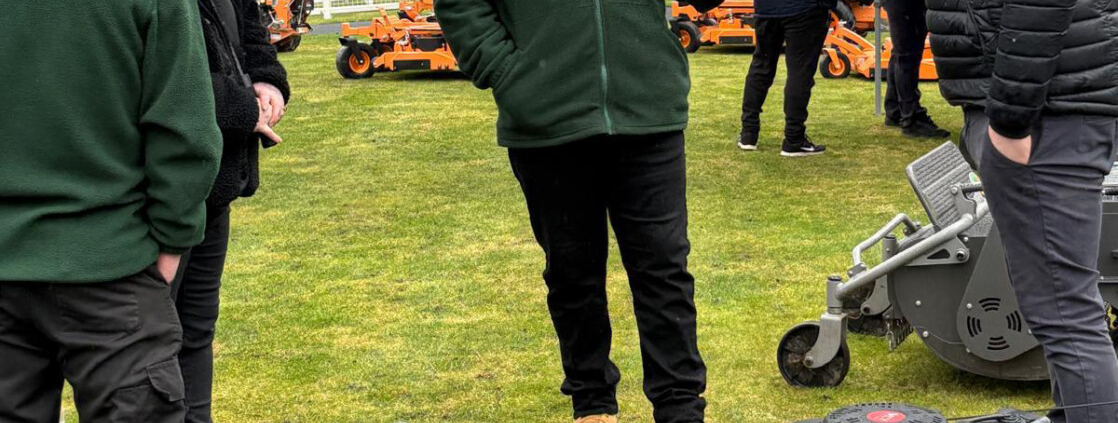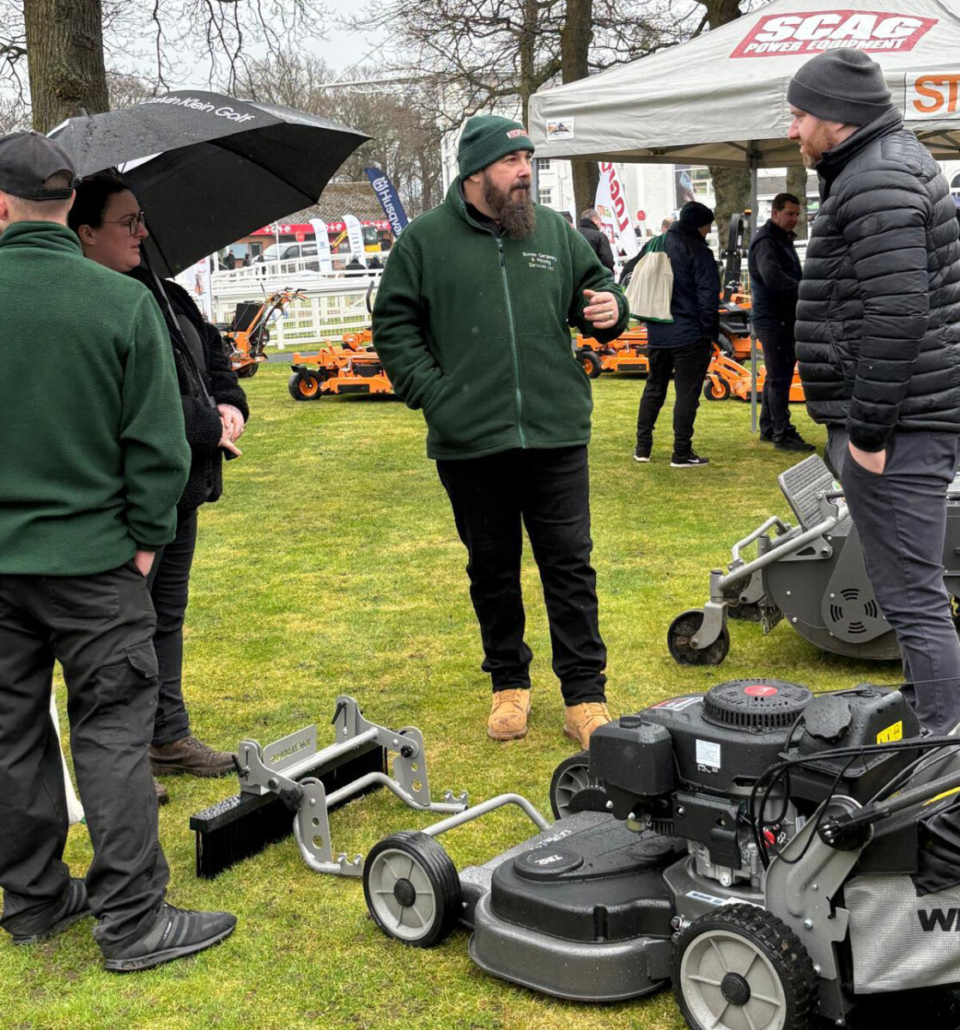Top man for a top job
Top man for a top job: Scott MacCallum heads to the Scottish Trossachs to catch up with an old friend in a new job.
When a top job becomes available you know that, within the upper echelons of the industry involved, there will be a rush to polish CVs and Google the trendiest, most up-to-the-moment interview questions.

Top man for a top job
There are a few roles which would be at the top of many sports turf manager’s wish list and very high among those would be that of Director of Golf Course and Estate at Loch Lomond Golf Club.
Loch Lomond is one of those special places with a mystique borne out of the fact that for many golfers, it was only when the gates were opened for the Solheim Cup in 2000 and successive Scottish Opens from 1997 to 2010, that they could appreciate first hand the stunning layout and immaculate conditioning. It brings new meaning to the word “exclusive”.
So, when the job was advertised last year the jungle drums were beating. So loud, in fact, that they could be heard across the Atlantic in Nova Scotia, Canada.
Lee Strutt is a man who has never settled for the status quo. In fact, he could be seen as the poster boy for Norman Tebbit’s mantra, back in 1981, when he encouraged everyone to “get on your bike” and better themselves.
In the 30 years that I’ve known him, Lee has been responsible for Richmond Golf Club, in London; the GWest Project in Perthshire; the RAC Club in Epsom; Les Bordes Golf Club in southwest of Paris; and Cabot Cape Breton in Canada.
“None of my moves had ever been pre-planned, they were opportunistic and when I saw the Loch Lomond job being advertised, I knew that it had never been advertised before making it a unique opportunity,” said Lee, adding that he had been happy and content what he was doing in Canada
“I’m never upset by rejection. Quite often people will look at my career and think that I’ve had nothing but success. However, they haven’t seen all the jobs I’ve applied for, didn’t get a response, or got a response which was, ‘No thank you’.”
And before you ask. Lee never left any role with his tail between his legs. His work ethic, professionalism and general decency meant his departing employers were always as sorry to see him leave as his new employers were pleased to have acquired his services.
Lee had been told by a number of people that if he ever had the opportunity to work with Loch Lomond’s General Manager, John Blanch, he should take it.
“I’d heard so many good things about John from his time at Wentworth and then here that I reached out to him on Linkedin before applying for the job,” he said, adding that Ken Seims, long time Loch Lomond head man, was someone he identified as a mentor, while he was also extremely close to David Cole, the man who he was to replace, having himself moved onto an exciting new project near St Andrews.
One Teams call and an in-person on-site interview later and Lee’s ambition was being fulfilled.
“The question is always do you tell a panel what they want to hear or are you true to yourself and outline what you actually believe,” said Lee, of his second interview which came a few hours after he had had the opportunity to walk the golf course.
“I thought, no actually I’m going to tell them exactly what I’m going to do if I get the job.”
His approach worked. Having clinched the role, it appears to be the perfect fit. The country’s top rated inland golf course and a Director of Golf Course and Estate who not only has a passport as well-worn as that of Michael Palin, but also had time to become the only turf manager in the world to have the top greenkeeping distinctions from the top four greenkeeping associations – Master Greenkeeper from BIGGA, the top award from the GCSAA, the Canadian Master Superintendent and the Australian CSTM.
“I’m the only person with all four, although a good friend of mine from the States, Matt Gourley, should be joining me this year. I’m looking forward to celebrating with him becoming the second person to join the club!”
So, if you find yourself in your dream role, at a golf course which has ticked every box since the day it opened, what is left for you to do to make a positive impact? Standards are so high that improvements can be very hard to find.
One of the questions he had been asked was what does 30, 60, 90 days look like?
“I said that I’d spend the first 30 days getting to know people and to understand how they work. People – staff – are a really important component to me. The next 30 days were looking at our operations – what we’re doing on the estate, management processes, our equipment, some of the ambitions of the past. The last 30 days were about what we do going forward,” he explained.

Top man for a top job
“This is what I did and then at the end of my 90 days I sat down with John (Blanch) and said, this is what I see going forward. I’m looking at the agronomy, I’m looking at the presentation, I’m looking at our people.”
Given that he has gathered huge experience from around the world what has he taken from his time outside of the UK?
“I guess what I have learnt and developed is to communicate better and articulate what we need to do as well as I can. I keep saying to the team here that I’ve got three principles which I have carried through my career. They are transparency, respect, and trust. Without any one of those, it doesn’t work.”
While he believes his goals are in line with most top golf course managers, he does feel that there are many different ways of achieving those goals. “Everyone is different. I really like data. We have a weekly agronomic meeting where we look at all our data, green speeds, fertility, operations, trying to identify what our sweet spots look like.
“I don’t actually look at all the positives. I’m not wowed by the scenery and how beautiful this is. Because my job is all about what’s not right.”
Taking from the analogy of marginal gains, as preached by Dave Brailsford when he was head of British Cycling, and Formula One teams, Lee explained his philosophy.
“If you went to work for Formula One they’re not saying, ’Oh look at the lovely car, it’s all so shining’, It’s all about where can you save a tenth of a tenth? What needs to be done to motivate the team when changing tyres?
“That’s what I do. I focus on everything that’s not right,” said Lee, who admitted that since he started last August, he had yet to play the golf course, claiming he wouldn’t get past the 1st without finding something he wasn’t happy with.
So, let’s have an example of how his approach works on a day-to-day basis.
“We’ve revisited our agronomic approach and decided to strip it right back and rebuild, instead of turning around and saying, ‘Well in the past X, Y and Z was done.’ Let’s assume we don’t need to apply X, Y and Z and see what happens.
“So, we’re now learning about what actually the site wants and needs and then delivering it. You are not being influenced by a previous approach, even if it was that which got the course to an outstanding level. It is all about focusing on continuous improvement,” said Lee, who attributes Adrian Archer, former Course Manager of Broadstone Golf Club, in Poole, as the man who set him on his greenkeeping path and, in particular, pushed him into attending Sparsholt College.
“Sometimes you have to go back and look at that recipe and go, that recipe’s good. How do I improve it? Or sometimes it’s a case of stripping something right back and rebuilding it. You might get to the point where the results are the same, but there’s now a greater potential for further improvement.”
Loch Lomond was designed by the great Tom Weiskopf and opened in 1993 and while it has always been a majestic golf course it was challenged by the eye-wateringly high rainfall levels endured by local residents, Loch Lomond’s members and staff. The joke about locals having developed webbed feet comes from an average of two and a half metres of rain per annum and is not totally fanciful!
Over recent years, and before Lee’s time, the club invested £7.5 million to sand cap the entire site.
“They did a phenomenal job with the sand capping. It was started before Covid and completed in 2022. A new irrigation system has also been installed,” said Lee.
“However, it’s only part of that silver bullet because what has happened is that you’ve added an inert sand and we’ve got to change that sand into more of a root zone so it’s not so inert.
You need more biology and that’s something that we’re working on now.
“How we can evolve the plant to benefit from all that sand capping and for the plant to grow and to grow to be happy. So that’s one of our programmes that we’re working on, and it will help fine-tune presentation and playability.”

Top man for a top job
What constitutes success for Lee?
“That is a brutal question. I was chatting to a guy yesterday and we were talking about how do you get to a state of satisfaction? I do think that satisfaction is the closest I can get to success.
“If I have maxed out on all the opportunities to make things better, that to me would be satisfaction and would mean that I’ve succeeded.
Another area where he is seeking to make improvements is in the facility for the 38 members of his team – which includes six in the garden team, three in the workshop and the rest on the golf course.
“When I arrived, I thought that our facility of workshops, offices and mess room, built from breeze block, looked very austere. So, I’m working to improve things. I’ve got pictures of the team members up on the walls, while I’ve got hold of two fabulous leather armchairs for this room. I’m also having a table specially built from wood from the course for meetings, while the chairs are ideal for one-to one chats with staff, talking to reps etc,” said Lee, as he and I tested the comfort levels of the chairs.
Lee has inherited an extremely fine group of people, who have bought into his three values – remember, transparency, respect and trust – while he is also keen to encourage those looking to change career to join the industry.
“I’ve got a guy in my team that used to run building sites. He now works for us. I’ve got a guy that used to repair submarines. He now works for us. I’ve got a guy that spent 17 years as a court officer. He’s now greenkeeping, and a guy who spent five years as a video editor. He said that he just wanted to scratch that itch. They all have a work ethic,” said Lee.
“The issue with school kids is they don’t know anything different, so they can start greenkeeping and then wonder if they should try something else? Whereas the people that have got a past career, they’ve got something to associate and they’ve had enough time to think that they want more of this and less of that.
“I would say we, as an industry, need to find a means whereby we can say to people out there who had had a first career, that we can give you an opportunity for a second career.”
Speaking with Lee you quickly sense that here is a man who has got his teeth well into his new role and that he won’t stop until he finds satisfaction… which you suspect will always just sit tantalisingly outside of his grasp.
So, it is fair assumption that while Lee was absolutely delighted to have heard the sound of those jungle drums all the way in Canada last year, he won’t be listening out for them again any time soon.























